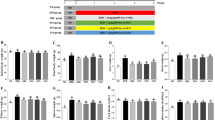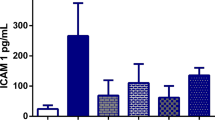Abstract
To examine the effect of saltwort (Salicornia herbacea) on blood cholesterol and lipid metabolism, hyperlipidemia was induced in animal rats. Saltwort extract was then administered to the rats for 5 weeks, after which, blood biochemical changes were determined. Saltwort treatment resulted in a significant reduction of the levels of total cholesterol, blood triglyceride, and LDL-cholesterol. In contrast, the expression levels of HDL-cholesterol were increased at saltwort treatment group. The aspartate aminotransferase (AST: serum SGOT) value of the saltwort administration group was significantly reduced and the blood alanine aminotransferase (ALT: serum SGPT) levels decreased significantly in comparison to those in the negative control group. Degeneration of hepatic tissues due to the consumption of a high lipid diet for a long period of time was reported in the negative control group. On the other hand, in the saltwort administration group, a substantial reduction in the accumulation of lipid droplets in the cytoplasm was seen, and in addition, it was confirmed that the degeneration of hepatic tissues recovered almost to level of that of the normal control group. These data suggest that saltwort extract represents an excellent candidate for protection of rat hepatocytes from high fat diet-mediated damage.
Similar content being viewed by others
References
Kim YA. Isolation and characterization of secondary metabolites from the salt marsh plant Salicornia herbacea L. PhD thesis, Korea Maritime University, Pusan, Korea (2005)
Greenway H, Munns R. Mechanism of salt tolerance in Ronhalophytes, Ann. Rev. Plant Physio. 83: 510–516 (1980)
Kim YS, Jeong YO, Park JC, Huh MR. Growth characteristics and mineral concentrations in glasswort as affected by NaCl concentration. J. Korean Plant. Human. Environ. 5: 239–247 (2002)
Lee JT, An BJ. Detection of physical activity of Salicornia herbacea L. Korean J. Herbol. 17: 61–69 (2002)
Rogers DJ, Loveless RW. Electron microscopy of human erythrocytes agglutinated by lectin from Codium fragile sp. tomentosoides and pseudohaemagglutinin from Ascophyllum nodosum. J. Appl. Phycol. 3: 83–86 (1991)
Korea National Statistical Office. Annual report of the cause of death statistics. Korea National Statistical Press, Seoul, Korea. pp. 2–5 (2008)
Mettson FH, Grundy SM. Comparison of effects of ditary saturated monounsaturated and polyunsaturated fatty acids on plasma lipids and lipoproteins in man. J. Lipid Res. 26: 194–200 (1985)
Kohomoto TF, Fukui H, Takaku Y, Machida T, Mitsuoka T. Effect of isomaltooligosaccharide on human fecal flora. Bifidobacteria Microflora 7: 61–67 (1988)
Han SK, Kim SM. Antioxidative effect of Salicornia herbacea L. grown in closed sea beach. J. Korean Soc. Food Sci. Nutr. 32: 207–210 (2003)
Lee JT, Jeong YS, An BJ. Physiological activity of Salicornia herbacea L. and its application for cosmetic materials. Korean J. Herbol. 17: 51–60 (2002)
Cha JY, Jeon BS, Park JW, Kim BK, Jeong CY, Ryu JS, Choi CK, Cho YS. Hypocholesterolemic effect of yogurt supplemented Salicornia herbacea L. extract in cholesterol-fed rats. J. Life Sci. 14: 747–751 (2004)
Lee CH, Kim IH, Kim YE, Oh SW, LEE HJ. Determination of betaine from Salicornia herbacea L. J. Korean Soc. Food Sci. Nutr. 33: 1584–1587 (2004)
Kang SM, Shim JY, Hwang SJ, Hong SG, Jang HE, Park MH. Effect of saengshik supplementation on health improvement in dietinduced hypercholesterolemic rats. J. Korean Soc. Food Sci. Nutr. 32: 906–912 (2003)
Lee JS, Ahn KH, Park KJ. Ameliorative effects of pine needle oil on liver protection and lipid metabolism of alcohol-fed rats. Food Sci. Biotechnol. 14: 99–101 (2005)
Park KJ, Kim HY, Chang BJ, Lee HH. Ameliorative effects of soy 11s protein on liver damage and hyperlipidemia in alcohol-fed rats. Biol. Pharm. Bull. 27: 1636–1641 (2004)
Cho SH, Ha TY. In vitro and in vivo effects of prosomillet and sorghum on cholesterol metabolism. Food Sci. Biotechnol. 12: 485–490 (2004)
Lee JS, Kim HY, Park KJ, Lee HH. Effects of soybean embryo on liver protection and lipid metabolism of alcohol-fed rats. Food Sci. Biotechnol. 14: 102–107 (2005)
Samuel P, McNanara DJ. Dfferential absorption of exogeneous and endogeneous cholesterol in man. J. Lipid Res. 24: 265–269 (1983)
Lim HJ, Chol KH, Cho RW. The effects of functional tea supplement with medical nutrition therapy on the blood lipid levels and antioxidant status in subjects with hyperlipidemia. J. Korean Soc. Food Sci. Nutr. 34: 42–56 (2005)
Kannel WB, Dawber TR, Frieman GD. Risk factor in coronary heart disease continous and grade; Primary screens of multiple risk factor intervention trial (MEFIT). J. Am. Med. Assoc. 256: 2853–2870 (1964)
Goldstein JL, Brown MS. Familial hypercholesterolemia. A genetic regulatory defect in cholesterol metabolism. Am. J. Med. 58: 147–152 (1975)
Park KJ, Lee MJ, Kang H, Lee HH. A medicinal herb complex, protects liver cell damage induced by alcohol. Biol. Pharm. Bull. 25: 451–1455 (2002)
Park KJ, Hwang EK, Park CS, Lee JS. The effect of Codium fragile (Chlorophyta) extract on hepatic dysfunction and hyperlipidemia in rats. Korean J. Environ. Biol. 28: 79–85 (2010)
Author information
Authors and Affiliations
Corresponding author
Rights and permissions
About this article
Cite this article
Park, K.J., Cho, M.H., Kim, S.Y. et al. Ameliorative effect of saltwort (Salicornia herbacea) extract on hepatic dysfunction and hyperlipidemia in rats. Food Sci Biotechnol 21, 331–337 (2012). https://doi.org/10.1007/s10068-012-0044-y
Received:
Revised:
Accepted:
Published:
Issue Date:
DOI: https://doi.org/10.1007/s10068-012-0044-y




